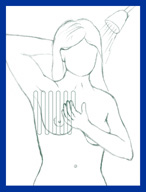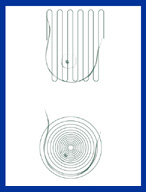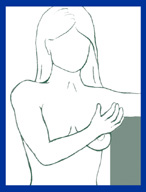A three-step plan for breast health & preventive care
This three-step plan helps you be proactive about maintaining your breast health. It's also part of a broader preventive approach to breast health that empowers you to take control. Talk to your doctor to determine the best timing and approach for your situation.
Not sure when to start having a conversation about breast health? Advocate recommends:
- Starting at age 25, make sure your doctor regularly asks questions about your family history of breast and other cancers during regular checkups. Your doctor will assess if you’re average, intermediate or high risk for breast cancer.
- If you’re high risk, your provider may give you a referral to a high-risk breast clinic or a genetics counselor if it’s appropriate.
Note: For the steps listed here, as every woman’s risk for developing breast cancer is different, ages should be considered averages.
Step 1: physician breast exam
If you’re age 20-39, you should typically have a physician exam to check your breasts every three years. If you’re age 40 and up, talk with your primary care doctor about establishing a screening mammogram plan.
Women with a personal or family history of breast cancer should get more frequent exams because they’re at a higher risk for developing breast cancer.
Step 2: breast self-exam
A monthly breast self-exam allows you to get to know your breasts better, which will help you notice if something isn’t quite right. This quick self-exam takes about five minutes and should be done by every woman age 20 and up.
There are two parts to a self-exam: how your breasts look and how they feel.
How they look:
Before putting on a bra, stand or sit in front of a well-lit mirror with your arms relaxed at your sides. Take a good, careful look. And don’t be shy. Do you see anything unusual? Check for changes in the size, shape and contour of each breast, including the nipple. Also look for puckering, dimpling or changes in skin texture.
Take a look at yourself from different angles and arm positions. There’s no such thing as a bad angle here. Keep your hands at your side, raise your arms overhead, place your hands firmly on your hips (which will help tighten your chest wall muscles) and even bend forward.
How they feel:
Use the pads of your three middle fingers—moving them in an overlapping circular motion about the size of a dime over your breasts. Move up and down from the outside of the breast (under your armpit) toward the middle of your chest, making sure to cover every area of the breast. Examine up to your collarbone and down to the bottom of the ribcage.
Remember you are feeling for lumps, bumps or anything that may seem different from your last monthly exam.
While not every lump is breast cancer, it is important to let your doctor know if you find a lump or anything that feels different or concerns you.
How to perform a self-exam:
The best time to do your monthly breast self-exam is about a week after your period starts. If you have gone through menopause, you should perform your breast self-exam on the same day each month.
In the shower: Raise one arm. With fingers flat, touch every part of each breast and the area around it, gently feeling for a lump or changes under the skin. Use your right hand to examine your left breast, your left hand for your right breast.

Lying down: Place a towel or pillow under your right shoulder and your right hand on your forehead, palm up. Examine your right breast with your left hand pressing gently but firmly. Then use your finger and thumb to gently squeeze your nipple, watching for any discharge. Repeat by examining the left breast in the same way.

Vertical and Circular: Fingers flat, press gently in vertical lines or small circles, starting under your arm, and move in toward the nipple. Be sure to cover your entire breast area. Repeat with left breast area.

Resting Your Arm: With your arm resting on a firm surface, use the same method to examine the underarm area. This is breast tissue also.
If at any time you notice changes, see your physician right away.

This self-exam is not a substitute for periodic examinations by a qualified physician.
Want more detailed instructions? Ask your doctor to show you how to perform a self-exam so you recognize how to feel for any unusual lumps and changes in your breasts.
What radiologists look for on a mammogram
What does a lump feel like?
Your breasts are made up of tissues of varying consistencies. The upper, outer part of your breast usually feels firm and bumpy, while the surrounding tissue in the inner and lower parts of your breasts is soft. Doing a breast self-exam monthly will help you recognize how your breasts normally feel—and when something changes and doesn’t feel quite right.
Not all lumps are cancerous, nor do all lumps feel the same. Lumps that are painless and hard with irregular edges are more likely to be cancerous. But some cancerous growths can be soft, rounded or painful. If you notice any new or suspicious lumps, call your physician right away.
5 steps to take after finding a lump
First, don’t panic. Finding a lump does not automatically mean you have breast cancer. In fact, about 85-90% of breast lumps are not cancerous. Still, you shouldn’t ignore it. Instead, you should:
- Call your doctor and schedule an appointment to be examined as soon as possible. Early diagnosis is key to survival – the sooner you are diagnosed, the better your chances for beating it.
- Your doctor will conduct a breast exam and may order diagnostic testing, which could include a mammogram and/or ultrasound.
- If the results of your diagnostic testing are abnormal, your doctor will likely order a breast biopsy, in which a sample of tissue is taken from your breast to be examined for possible cancer. The biopsy, which can be performed in an out-patient setting, is used to determine if a lump is cancerous or if it is a benign breast condition.
- If the advanced diagnostic tests determine the lump is breast cancer, additional tests will be performed to determine the extent of the disease.
- A multi-disciplinary team of breast cancer specialists will work together to develop your personalized and comprehensive care plan.
Step 3: mammography
Annual mammograms can help detect cancer in its earliest stage, which helps save lives. A mammogram can detect a tumor as tiny as a pinhead up to two years before it grows to a size that you or your doctor can feel.
Your first mammogram is often considered the “baseline” mammogram—the one used to compare future mammograms to help identify changes in your breast tissue.
Are you at risk for breast cancer?
Knowing your chance of developing breast cancer can help you plan a routine screening schedule. Our breast health quiz estimates your five-year and lifetime risk and gives you an idea of what to do next based on your results.
Get care
We help you live well. And we’re here for you in person and online.
